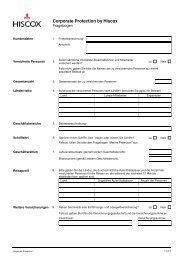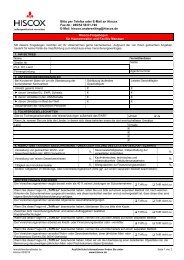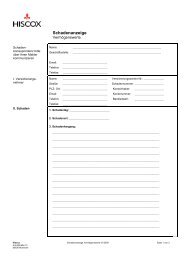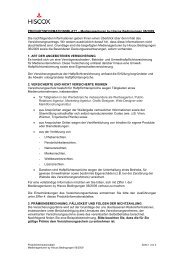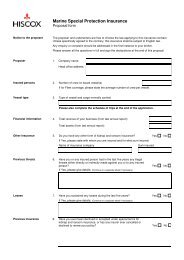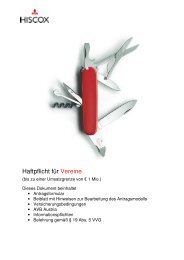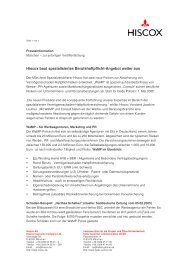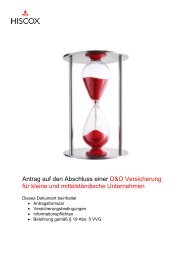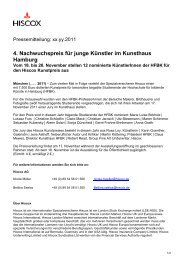Download PDF - Hiscox
Download PDF - Hiscox
Download PDF - Hiscox
Create successful ePaper yourself
Turn your PDF publications into a flip-book with our unique Google optimized e-Paper software.
Notes to the consolidated<br />
financial statements<br />
continued<br />
3 Management of risk continued<br />
3.2 Financial risk continued<br />
(f) Limitations of sensitivity analysis<br />
The sensitivity information given in notes<br />
(a) to (e) above demonstrates the estimated<br />
impact of a change in a major input<br />
assumption while other assumptions<br />
remain unchanged. In reality, there are<br />
normally significant levels of correlation<br />
between the assumptions and other<br />
factors. It should also be noted that these<br />
sensitivities are non-linear, and larger or<br />
smaller impacts should not be interpolated<br />
or extrapolated from these results. The<br />
same limitations exist in respect to the<br />
retirement benefit scheme sensitivities<br />
presented at note 31 to these financial<br />
statements. Furthermore, estimates<br />
of sensitivity may become less reliable<br />
in unusual market conditions such as<br />
instances when risk free interest rates<br />
fall towards zero.<br />
The sensitivity analyses do not take into<br />
consideration that the Group’s assets and<br />
liabilities are actively managed. Additionally,<br />
the financial position of the Group may<br />
vary at the time that any actual market<br />
movement occurs. For example, the Group’s<br />
financial risk management strategy aims to<br />
manage the exposure to market fluctuations.<br />
As investment markets move past various<br />
trigger levels, management actions could<br />
include selling investments, changing<br />
investment portfolio allocation and taking<br />
other protective action.<br />
3.3 Capital risk management<br />
The Group’s primary objectives when<br />
managing its capital position are:<br />
to safeguard its ability to continue<br />
as a going concern, so that it can<br />
continue to provide long-term growth<br />
and progressive dividend returns<br />
for shareholders;<br />
to provide an adequate return to the<br />
Group’s shareholders by pricing its<br />
insurance products and services<br />
commensurately with the level of risk;<br />
to maintain of an efficient cost<br />
of capital;<br />
to comply with all regulatory requirements<br />
by a significant margin; and<br />
to maintain financial strength ratings<br />
of A in each of its insurance entities.<br />
The Group sets the amount of capital<br />
required in its funding structure in proportion<br />
to risk. The Group then manages the<br />
capital structure and makes adjustments<br />
to it in the light of changes in economic<br />
conditions and the risk characteristics<br />
of the underlying assets. In order to obtain<br />
or maintain an optimal capital structure the<br />
Group may adjust the amount of dividends<br />
paid to shareholders, return capital to<br />
shareholders, issue new shares, assume<br />
debt, or sell assets to reduce debt.<br />
The Group’s activities are funded by a<br />
mixture of capital sources including issued<br />
equity share capital, retained earnings,<br />
Letters of Credit, bank debt and other<br />
third-party insurance capital.<br />
The Board ensures that the use and<br />
allocation of capital are given a primary<br />
focus in all significant operational actions.<br />
With that in mind, the Group has developed<br />
and embedded sophisticated capital<br />
modelling tools within its business. These<br />
join together short-term and long-term<br />
business plans and link divisional aspirations<br />
with the Group’s overall strategy. The<br />
models provide the basis of the allocation<br />
of capital to different businesses and<br />
business lines, as well as the regulatory<br />
and rating agency capital processes.<br />
During the year the Group was in<br />
compliance with capital requirements<br />
imposed by regulators in each jurisdiction<br />
where the Group operates.<br />
There were no changes in the Group’s<br />
approach to capital risk management during<br />
the current or prior year under review.<br />
Gearing<br />
The Group currently utilises short- to mediumterm<br />
gearing as an additional source of funds<br />
to maximise the opportunities from strong<br />
markets and to reduce the risk profile of<br />
the business when the rating environment<br />
shows a weaker model for the more volatile<br />
business. The Group’s gearing is obtained<br />
from a number of sources, including:<br />
Letter of Credit and revolving credit<br />
facility – the Group’s main facility<br />
currently in place is for a total of<br />
£350 million which may be drawn as<br />
cash (under a revolving credit facility),<br />
Letter of Credit or a combination<br />
thereof, providing that the cash portion<br />
does not exceed £200 million. This<br />
facility was secured during 2008 by<br />
the Company’s subsidiary <strong>Hiscox</strong> plc.<br />
The Letter of Credit availability period<br />
ends on 31 December 2009. This<br />
enables the Group to utilise the Letter<br />
of Credit as Funds at Lloyd’s to support<br />
underwriting on both the 2009 and<br />
2010 years of account. The revolving<br />
credit facility has a maximum five year<br />
contractual period for repayment.<br />
70 Notes to the consolidated financial statements <strong>Hiscox</strong> Ltd Report and Accounts 2009<br />
At 31 December 2009 US$225 million<br />
was drawn by way of Letter of Credit<br />
to support the Funds at Lloyd’s<br />
requirement and a further £138 million<br />
by way of cash (2008: £137.5 million<br />
and US$130 million respectively) to<br />
support general trading activities;<br />
external Names – 27.5% of Syndicate<br />
33’s capacity is capitalised by thirdparties<br />
paying a profit share of<br />
approximately 17.5%;<br />
Syndicate 6104 at Lloyd’s – with an<br />
approximate capacity of £43 million<br />
for the 2009 year of account (2008<br />
year of account: £34 million). This<br />
Syndicate is wholly backed by external<br />
members and takes a pure 2009 year<br />
of account quota share of Syndicate<br />
33’s international property catastrophe<br />
reinsurance account;<br />
gearing quota shares – historically the<br />
Group has used reinsurance capital to<br />
fund its capital requirement for short-term<br />
expansions in the volume of business<br />
underwritten by the Syndicate; and<br />
qualifying quota shares – these are<br />
reinsurance arrangements that allow<br />
the Group to increase the amount<br />
of premium it writes in hard markets.<br />
The funds raised through Letters of Credit<br />
and loan facilities have been applied to support<br />
both the 2009 year of account for Syndicate<br />
33 and the capital requirements of <strong>Hiscox</strong><br />
Insurance Company (Bermuda) Limited.<br />
Financial strength<br />
The financial strength ratings of the Group’s<br />
insurance company subsidiaries are<br />
outlined below:<br />
Standard<br />
A.M. Best Fitch & Poor’s<br />
<strong>Hiscox</strong> Insurance<br />
Company Limited<br />
<strong>Hiscox</strong> Insurance Company<br />
A (Excellent) A A (Strong)<br />
(Bermuda) Limited<br />
<strong>Hiscox</strong> Insurance Company<br />
A (Excellent) A –<br />
(Guernsey) Limited<br />
<strong>Hiscox</strong> Insurance<br />
A (Excellent) A –<br />
Company Inc. A (Excellent) – –<br />
Syndicate 33 benefits from an A.M. Best<br />
rating of A (Excellent). In addition, the<br />
Syndicate also benefits from the Lloyd’s<br />
ratings of A (Excellent) from A.M. Best<br />
and A+ (Strong) from Standard & Poor’s.<br />
Capital performance<br />
The Group’s main capital performance<br />
measure is the achieved return on equity<br />
(ROE). This marker best aligns the<br />
aspirations of employees and shareholders.<br />
As variable remuneration, the vesting of<br />
options and longer-term investment plans<br />
all relate directly to ROE, this concept is<br />
embedded in the workings and culture of




